hey Mits, you know this Bhagwandin guy? ![]()
@Former Member posted:hey Mits, you know this Bhagwandin guy?
Perhaps.![]()
Wonder what Miss Ivy Leggs up to? Missing my coffee.
World’s 2nd largest oil producer told to invest now in Guyana, or pay more later

Saudi Arabia’s Deputy Minister for Investors Outreach, Badr Al Badr, arrives at the Arthur Chung Conference Centre on the outskirts of Georgetown, Guyana, on Saturday July 9, for an investment conference.
A delegation from Saudi Arabia was told on Saturday that investing now in South America’s newest oil producing nation, Guyana, would be less expensive than even a year and a half down the road since the new petroleum hotspot is undergoing a major economic boom.
“I am just going to say to you one thing today, come and invest now, it will be too expensive for you to invest a year and a half from now, the decision is in your hands, the ball is in your court,” Guyana’s President, Dr. Irfaan Ali, told the visiting Saudi group, comprising government and private sector representatives.
As Guyana mulls NOC, Saudi Arabia markets itself as knowledgeable energy partner
Since ExxonMobil made its first world-class discovery at the Liza field in 2015, the company has found nearly 11 billion barrels of oil equivalent spread over 30 wells. The unprecedented deepwater success has seen investor interest in the country of just over 750,000, people at an all-time high.
“We do not have to sell Guyana anymore,” Mr. Ali told the gathering. “We just need to stick to the facts and the truth, and Guyana is blessed to sell itself naturally.”
The young Guyanese leader said the government is embarking on a journey that must position the country twenty-five years ahead of anyone else.
“We want to partner with you, we want to partner with the world. But you must understand that we also want to move quickly. We have an obligation to the people of this country to deliver to them as fast we can,” Mr. Ali urged.
Saudi Arabia’s Deputy Minister for Investors Outreach, Badr Al Badr, said tapping into the opportunities in Guyana is important since the Caribbean has become a priority zone for investments and business partnerships, for the Gulf oil producing state.
Saudi investment minister promises ‘strong capabilities and assets’ in Guyana partnership
“Saudi Arabia is a good partner for Guyana, since it is the 16th largest economy in the world,” Al Badr said. “Additionally, for the past three years, the Kingdom has had a GDP growth averaging 4% over the last 25 years, and this year [2022] the economy will grow by over 9%.”
He also pointed out that Saudi Arabian companies can bring knowledge in the introduction of the technologies and supplies needed for Guyana’s transition to becoming a major oil producer.
Rich countries have “no moral authority” to tell Guyana, Suriname, T&T to keep oil in the ground
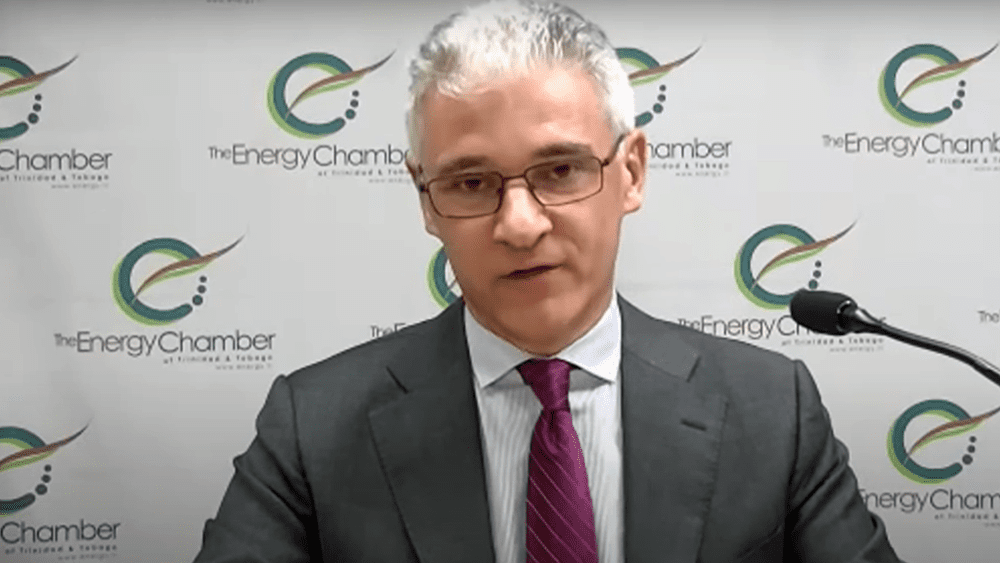
Dr. Dax Driver - Chief Executive Officer (CEO) of the Trinidad and Tobago Energy Chamber.
The climate crisis has seen wealthy countries that have built and transformed their economies with oil and gas, calling on countries in Africa, South America and the Caribbean, to hold off on developing their hydrocarbon resources.
Calls have mounted for producers like Guyana, Trinidad, and Suriname to abandon the development of their oil and gas resources for fear that it could exacerbate climate change. But President and Chief Executive Officer (CEO) of the Energy Chamber in Trinidad, Dr. Dax Driver, is of the firm view that those nations have no just grounds to make such a demand.
Dr. Driver weighed in on the discourse during the “Transforming Guyana” webinar by the Guyana Business Journal & Magazine on Wednesday. The panel also included the Executive Director of Guyana’s Environmental Protection Agency (EPA). Kemraj Parsram, and Dr. Lorraine Sobers, lecturer at the University of the West Indies, St. Augustine.
Using London as an example, the Energy Chamber CEO explained that the city was built largely on coal mining for electricity which continued up until the early 2000s. Different fuels emit different amounts of carbon dioxide (CO2) in relation to the energy they produce when burned, and coal is the biggest emitter.
Aside from London, the modern world, Driver said, was also built on fossil fuels.
Rich countries must exit oil production first, new climate report states | OilNOW
“So let me be frank – nobody living in affluent London has the moral authority to tell anyone living in Georgetown, or Paramaribo or Port-of-Spain that they need to leave their oil and gas in the ground to stop climate change,” he stressed.
Though the Caribbean has contributed little to the climate crisis, it stands to lose the most from it and this, according to Dr. Driver, should be at the forefront of policy creation. He was keen to note that ending production will have no impact on climate change – it is the consumption. So, activities like coal mining, he said, “should be stopped.”
Dr. Driver added that switching to natural gas power is the environmentally friendly option before the full transition to renewable energy.
“Coal to gas is the most effective short-term change that needs to happen in the world to reduce emissions,” he continued.
Russia’s invasion of Ukraine has forced some nations to switch back to coal-fired power. But it has also increased the need for natural gas to fill the void left by Russia as western countries wean themselves off Russian gas. And this is something that the Caribbean should pay attention to, Dr. Driver pointed out further.
Guyana is already making headway with its massive gas-to-energy project, which will see a guaranteed minimum of 50 million cubic feet per day (mmcfd) of natural gas being transported onshore from ExxonMobil’s Liza 1 and 2 fields in the Stabroek Block.
Guyana profiting more from oil production than Exxon, Hess and CNOOC combined – Analyst
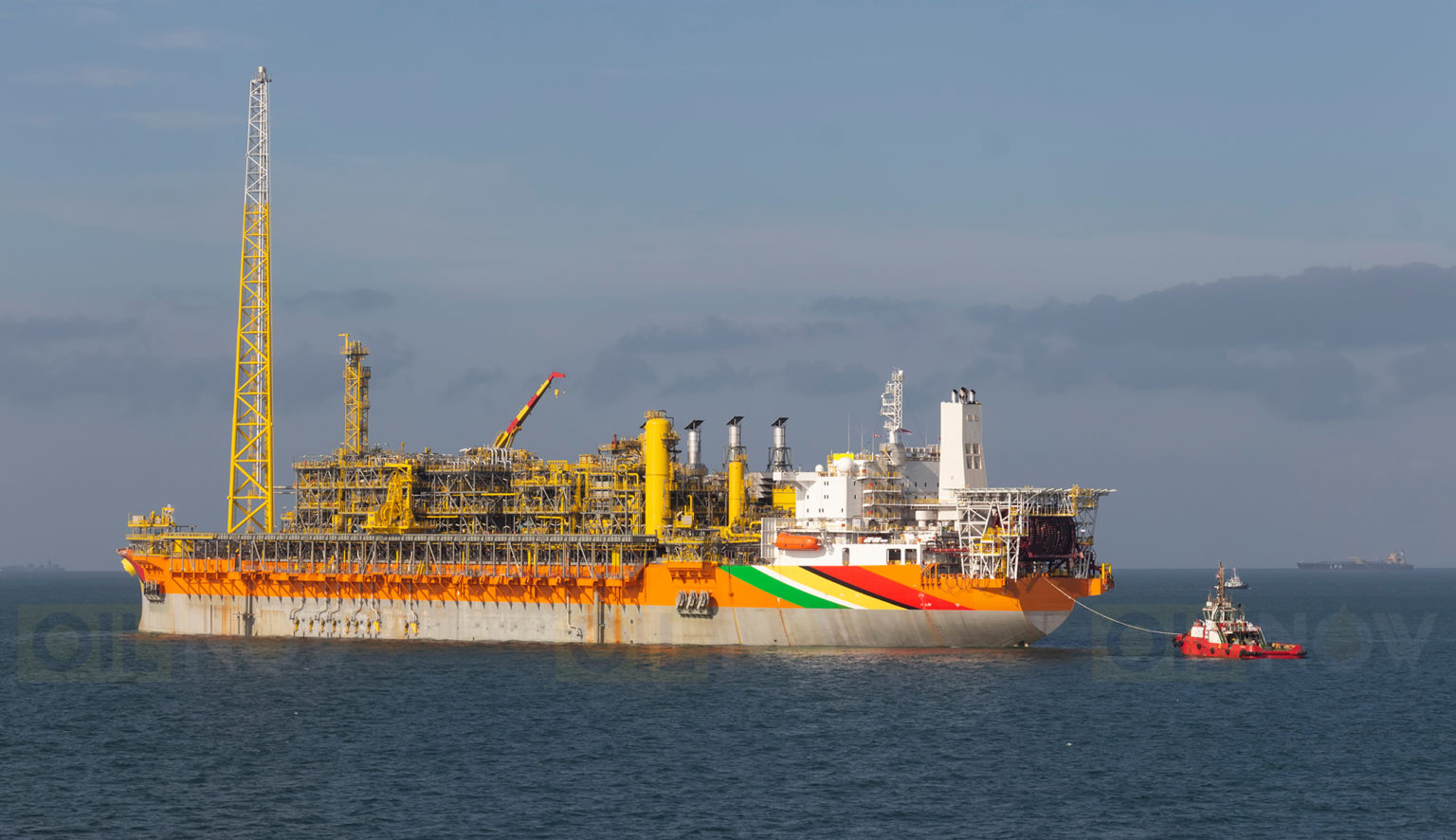
The Liza Destiny FPSO, Guyana's first oil production vessel.
A new review of the consolidated financial statements for ExxonMobil Guyana, Hess and CNOOC for the period ended December 2021 confirms that the South American country is profiting more from the offshore oil production activities than all three companies combined.

Joel Bhagwandin
Financial Analyst, Joel Bhagwandin, has shown that Guyana’s share of profit oil and royalty for financial year (FY) 2021 exceeded the companies’ net take in profit oil for the same period by around 11 billion Guyana dollars.
“Guyana’s total share of profit oil and royalty for [fiscal year] FY 2020 amounted to GY$25.5b which increased to GY$79b in FY 2021 – while the oil companies net take in profit oil for FY2020 amounted to GY$22b, which increased to GY$68.1b FY 2021,” Bhagwandin said.
He explained that this means Guyana’s share in profit and royalty is greater than the net profit of the oil companies.
Guyana’s oil fund earns GY$266M interest in Q2
The analyst noted a favourable variance between Guyana’s take as reported by ExxonMobil, and what was deposited into the Natural Resource Fund (NRF).
“The actual profit oil and royalty for the said period as reported in the NRF, however, stood at GY$41.3b in FY2020 representing a favourable variance of GY$15.8b or 88% while for FY 2021 Guyana’s total share stood at GY$85.3b as reported in the NRF, representing GY$17.1b or 25% more than what is reported in the financial statements of the oil companies,” Bhagwandin said.
This, he explained, is due to multiple factors.
One factor is a difference in exchange rates used by ExxonMobil and the Central Bank of Guyana. Exxon would use the prevailing market rate, somewhere about GY$215 = US$1. Central Bank would use a rate closer to GY$209.2 = US$1.
Another factor, to a greater extent, is because Guyana receives its profit in crude, not revenue. The government is therefore able to secure to higher revenues through the sale of its share.
In the Stabroek Block PSA, 75% of the oil produced is set aside for the International Oil Companies to recoup investments made in their exploration and production operations. Guyana is not required to plug any funds into these activities. 25% remains as profit, to be split 50/50 between Guyana and the Stabroek Block consortium. This means the partners get 12.5%, while 12.5% goes to the government.
US$200M more withdrawn from Guyana oil fund
While this is an equally split profit, royalty tips the scale. The consortium pays 2% of gross revenues out of its share of the profit. That leaves the consortium with 10.5% and the government with 14.5%.
Guyana forging ahead with capacity building for electric vehicle industry
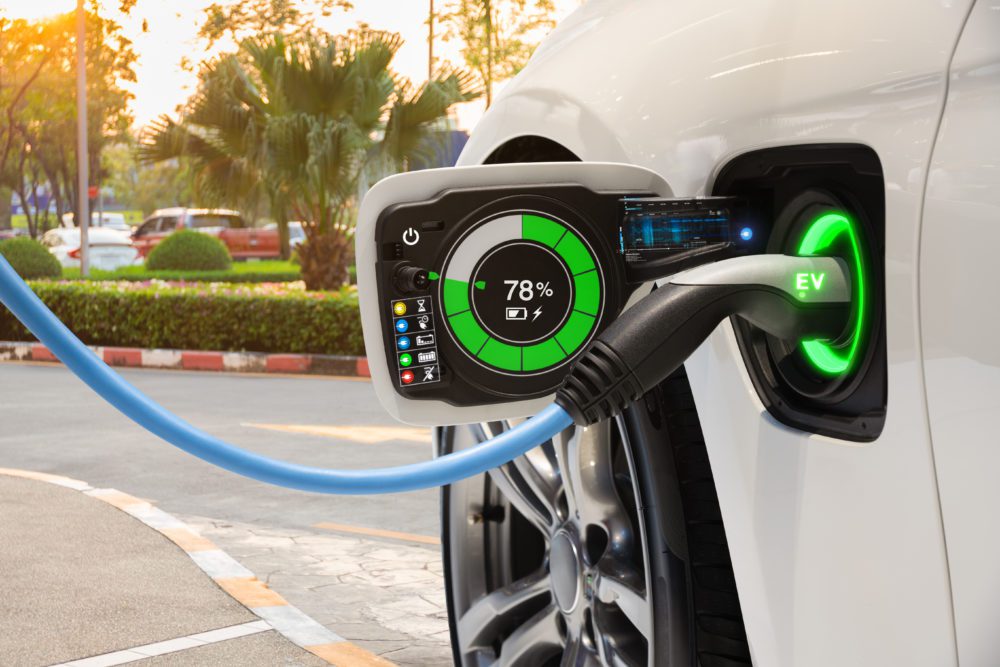
The Guyana Energy Agency (GEA) has taken steps to build the capacity to repair and maintain electric vehicles as the country continues to pursue low carbon development opportunities. To this end, the GEA hosted an Electric Vehicle Maintenance and Repairs Workshop last week – a programme funded with support from the Inter-American Development Bank (IDB) and facilitated by Mega Power.
On Friday, during the workshop’s closing ceremony at Cara Lodge, Georgetown, Guyana’s Prime Minister, Brigadier (retired), Mark Phillips joined in celebrating what he labelled a “momentous occasion”, particularly as the government works to reduce the country’s carbon footprint.
Guyana is in the process of procuring electric vehicle charging stations. Motor vehicle retailers have been importing these cars, which cost less to purchase due to the removal of duty.
Phillips explained that with Guyana’s drive to significantly slash the price of electricity, having electric vehicles will become very viable.
“While the proliferation of electric vehicles adds a new dynamic for the utility, lower electricity costs will certainly encourage diversification in the transport sector,” the Prime Minister stated.
He emphasised the importance of the training and stated that it is a step in the right direction as the country prepares for the introduction of fast-charging stations for electric vehicles in Regions Three, Four and Six this year. Bids for this project closed on May 31, with six companies expressing their interest to secure the contract.
Further, the Prime Minister highlighted also that possessing a cadre of trained and certified mechanics and auto-technicians in electric vehicle maintenance and repairs would give existing and potential vehicle owners additional confidence in the reliability of this technology.
First Tesla imported as Guyana pushes electric car industry | OilNOW
“Proper maintenance will also ensure the longevity of these types of vehicles in a healthy and safe environment,” he noted, and linked this upskilling directly to the government’s objective of developing Guyana’s human capital.
To this end, Prime Minister Phillips related, “As a country, we need to develop our human resources to drive a sustainable energy transition through continuous capacity building, training, public awareness, and education programmes. This workshop has contributed to boosting the country’s human capital to support such a transition.”
Out of 44 persons who applied, 12 persons were selected for this initial workshop.
With the prevailing state of affairs at GPL this could be another pink elephant like the Skeldon sugar factory.
Sachin, hope you don't miss the gravy train.
Development and use for electric vehicles are world-wide ongoing processes.
Guyana can balance the exploitation of her natural resources and protect the environment

Terrence Blackman, PhD and Utamu Bell
By Terrence Blackman, PhD and Utamu Bell – OilNOW
Transforming Guyana: Episode II, presented by the Guyana Business Journal (GBJ) and the Caribbean Policy Consortium (CPC), got underway via Livestream on Wednesday, July 13, 2022. Participants sought to explore ways Guyana can balance exploiting her natural resources while protecting the environment.
The series, Transforming Guyana, aims to bring together experts and prominent and diverse voices from Guyana and the Diaspora to discuss the impacts of Guyana’s oil and gas development, take a nuanced look at the opportunities and potential pitfalls ahead for the country, and explore strategies to maximise the positive impacts that oil revenues can have on Guyana’s people and future while mitigating the risks that other countries have faced, as well as identifying the most promising roles the Diaspora can play in this transition.
The focus was the essential conundrum for Guyana: the world must dramatically cut fossil fuel consumption to achieve its climate change goals. But climate change success may put developing countries like Guyana, rich in fossil fuels, in an almost no-win situation.
“Suppose there is no progress in combating climate change? In that case, developing countries are likely disproportionately harmed by floods, droughts, and other weather-related problems spawned by a warming planet. Likewise, suppose the world permanently moves away from using fossil fuels. In that case, the likely result will be a considerable reduction in the value of our natural wealth,” Dr. Terrence Blackman, GBJ Founder, said.
International Trade Consultant Dr. David E. Lewis then noted that the energy economy and growth, particularly in Guyana and the Region, is “hot,” noting that it’s the perfect time to take advantage of maximising investment opportunities and economic growth. He said maximising income and jobs should also be critical, as well as continue pushing on climate change issues and initiatives – particularly the Low Carbon Development Strategy, which Guyana is currently advancing. Dr. Lewis also noted the challenge of providing stable, reliable, affordable electricity access: “… the development of a reliable and sustainable grid and the situation with utilities, not only in Guyana…. to comment on the rest of the Caribbean where it’s a challenge in some countries, and how to blend in this opportunity in terms of national, regional energy production in Guyana and the Caribbean and how we use that to build up that efficiency and resilience of the grid and many of our utilities,” he said.
Former Dean of the Faculty of Natural Sciences of the University of Guyana and former Advisor to the Caribbean Community Climate Change Centre, Dr. Neville Trotz, shed light on the Paris Agreement.
“The whole idea is that by 2050 we’d be carbon neutral…the [Intergovernmenttal Panel on Climate Change] IPCC had called for a special 1.5°C report which we have been fully supporting… that report showed that the [world is on a] business-as-usual trajectory; nothing had changed really and we are likely not to achieve 1.5°C at the end of this century but rather by 2040. This is frightening… We are running out of time to meet the Paris Agreement’s objectives.”
“As a developing country, Guyana does not have the resources to transform the energy sector or to build resilience to climate change… Even if we stop putting fossil fuels in the atmosphere by tomorrow, we have enough in there to cause us quite a lot of harm, as we’re seeing in all droughts, forest fires, heat waves… We are living in a world committed to climate change. So, it is essential that we also look at adaptation which is as critical for us as mitigation….”
He added that fossil fuels would be part of the equation for some time as there will be a market for them as we aim to phase them out. Dr. Trotz further stressed the need to adapt to impacts caused by existing greenhouse gas compositions.
“One of our biggest constraints in addressing climate change issues, both on the mitigation side, which is about transforming the energy sector [and] is critical for the Caribbean, and on the adaptation side, which is building resilience to the changes that we are already living with, is a question of resources. We now have an opportunity to marshal the type of resources needed for that transformation in a proper time frame.”
He said Guyana could leave the resources in the ground or exploit and use resources generated from oil and gas to accelerate the transformation to zero carbon status.
“Our other option… is to exploit and use the resources that we generate from oil and gas to accelerate the transformation to zero carbon status for the energy sector and climate resilient Guyana through adaptation…. Guyana, with its oil revenue, could now be able to accelerate more. The highest priority for using fossil fuels should be transforming the energy sector to achieve zero carbon status…what I would recommend… the priorities for the resources from our oil wealth should go first of all to the implementation of the [Caribbean Risk Information System] CRIS, i.e. to build climate resistance to ensure that our coast, for instance, is protected from the sea-level rise… the transformation of our energy sector – 100% renewable in the globally prescribed timeframe… We should support energy security during the transition of the region to zero status.”
He said the Caribbean is committed to zero status by 2050 but does not have the resources and would have to borrow from overseas.
“It’s an opportunity for us to look internally at how these resources – Guyana, Suriname, Trinidad could contribute to the Caribbean… Guyana and Suriname can demonstrate how poor developing countries can face the paradox of being a fossil fuel producer while espousing the tenets of the Paris Agreement,” he said.
Executive Director of Guyana’s Environmental Agency (EPA), Kemraj Parsram, stressed the EPA’s mandate to promote, facilitate and coordinate effective environmental management and protection and the sustainable use of Guyana’s natural resources.
“We believe that environment and development are not mutually exclusive… our role here is to facilitate development and to ensure, in this case, that oil and gas are in keeping with the Environmental Protection Act and, of course, the broad environmental safeguards available… In the oil and gas sector and in our experience, most of the production projects went, and we required an Environmental Impact Assessment. That process was followed… we ensure that there are adequate and some key safeguards in place,” he assured the audience.
Scholar and Lecturer of the University of the West Indies (St. Augustine), Dr. Lorraine Sobers, said Guyana has unique challenges and opportunities. She said the country is susceptible to the current effects of climate change, noting the need for resilience with the rising sea levels, which have severe effects on agriculture, etc. She further stated, “Climate models show that the current seawall does not match what is anticipated. One of the major challenges we expect is climatic events; this is a cost. Guyana, small islands… are already paying for that. It’s a challenge to our development when funds need to be channeled towards recovery…”
Dr. Sobers hailed Guyana’s initiative of the carbon registry, and she added that the rest of the Caribbean and Africa support Guyana’s right to produce. “Guyana is set to produce over a million barrels per day before the end of the decade, and that is just astonishing growth… [The Caribbean Community] CARICOM is supporting Guyana’s right to produce, and so are the African countries,” she said.
President and Chief Executive Officer of The Energy Chamber of Trinidad and Tobago, Dr. Dax Driver, said no one has the moral authority to tell a country like Guyana to leave its oil in the ground. “Nobody living in affluent London has the moral authority to tell anybody living in Georgetown, Paramaribo, or Port of Spain that they need to leave their oil and gas in the ground to stop climate change. The affluence of this city, London, has been created through the fossil fuels which have built the modern world… Stopping fossil fuel production in the Caribbean will not impact global climate change. The problem is the consumption of fossil fuels… For countries like Guyana and Suriname, with these massive oil resources in place… the priority must be to fast-track the development of those resources. This is something that Guyana has done extremely well since its first discovery.”
Dr. Driver further asserted that the energy transition is here, and Caribbean people need to take advantage of it. He noted that the electrification of the transportation sector would drive a ticking clock for the oil industry. “The key is to get your resources to market as quickly as you possibly can… Otherwise, you’re going to be left with stranded assets,” he said. Driver also encouraged policymakers to invest heavily in the grid, noting that as the country’s [Gross Domestic Product] GDP grows, so will its electricity demand. He said the focus should also be placed on energy efficiency. Dr. Driver closed by warning against across-the-board subsidies, noting their negative impacts on efficiency.
About the Authors
Dr. Terrence Richard Blackman, associate professor of mathematics and a founding member of the Undergraduate Program in Mathematics at Medgar Evers College, is a member of the Guyanese diaspora. He is a former Dr. Martin Luther King Jr. Visiting Professor at Massachusetts Institute of Technology and a Visitor to The School of Mathematics at The Institute for Advanced Study. Dr. Blackman has previously served as Chair of the Mathematics Department and Dean of the School of Science, Health and Technology at Medgar Evers College, where he has worked for almost thirty years. He graduated from Queen’s College, Guyana, Brooklyn College, CUNY, and the City University of New York Graduate School. He is the Founder of the Guyana Business Journal & Magazine.
Utamu Belle is an award-winning Guyanese journalist with a career spanning over a decade. Her experience includes writing for print, television, and online media. She has worked as a Radio and Television host. She is the Founder of A-to-Z Media (Guyana) and a News and Digital Editor with Upscale Magazine.
@Former Member posted:Development and use for electric vehicles are world-wide ongoing processes.
This is indeed very deep. What a profound statement. ![]()
Political discussions and issues are definitely not for the foolhardy. ![]()
@Former Member posted:Political discussions and issues are definitely not for the foolhardy.
Note to yourself eh!
@Former Member posted:Development and use for electric vehicles are world-wide ongoing processes.
Not in Guyana. The only way for electric vehicles to be beneficial in a country, there has to be constant...electricity. Quite a concept ain't it?
Cain --- facilities for electric cars will be in Guyana ... it will be, Cain. ![]()

Electric cars in Guyana will be equipped with solar panels and pedals.

ExxonMobil officials interact with Guyanese business representatives at the Liza Phase One Supplier Development Forum (OilNOW file photo - 2018)
ExxonMobil Guyana will be hosting a Request For Information (RFI) clarification meeting on August 9, 2022, at the Marriott Hotel in Georgetown.
The company plans to put in place an agreement for the provision of Integrated Office Facility Management Services. The company is also planning to implement agreements for Integrated Residential Facility Management Services and for the provision of Catering, Cafeteria and Food Management Services – all to be done in and around Georgetown.
Exxon seeking multiple suppliers in Guyana as operations expand | OilNOW
As such, the meeting which starts at 9 am (Guyana time) is open to suppliers interested in providing those services.
Suppliers can contact cecil_maxwell@dai.com by August 1, 2022, to confirm seats.
The development of ExxonMobil’s projects and continued exploration success in the Stabroek Block is pushing the steady advancement of local capabilities and enhanced economic growth in Guyana.
The company has close to 4,000 Guyanese supporting its activities both onshore and offshore, an increase of more than 50% since 2019.
Guyana now producing over 300,000 barrels of oil per day – Bharrat
To date, Exxon has made over 30 discoveries at the Stabroek Block, amounting to nearly 11 billion oil-equivalent barrels.

Wazim Mowla
By Wazim Mowla – OilNOW
The United States is Guyana’s most important bilateral relationship. The United States remains a major power in the Western Hemisphere and holds significant influence worldwide. It is this influence, the potential investment stemming from US companies, and the institutional knowledge and expertise that it houses that can help Guyana achieve its own national and regional ambitions. Courting and strengthening this relationship will therefore be vital for Guyana’s future, affording the country a powerful ally while providing a window that will allow it to exercise influence in US policy to the wider Caribbean when needed.
More so than in prior decades, Guyana is in a unique position in its relationship with the United States, commanding increased attention from the latter due to its emergence as an oil and gas producer. Guyana’s growing economic clout and its role as an emerging regional leader in the Caribbean Community (CARICOM) is augmenting its relationship with the United States. While the asymmetry between the two remains vast, Guyana is closing this gap. US policy to the Caribbean, or CARICOM specifically, must now account for Guyana, especially as the US lens for the region has shifted since President Joe Biden assumed office in 2021.
Recently, the United States has deemphasized traditional security concerns in the Caribbean, focusing instead on addressing climate change and energy security. And since Russia’s invasion of Ukraine, which has seen the prices of foodstuff soar, food security has been added to this list. In each area, Guyana commands attention and simply, the United States cannot achieve its objectives in the region without sufficient participation from Guyana.
This is one reason for Guyana being the co-chair of the US-Caribbean joint committee on food security – an outcome from last month’s Summit of the Americas – recognising the leading role the latter is playing in decreasing CARICOM’s high food import bill through its 25×2025 plan. And regarding energy and climate change, Guyana’s longstanding protection of its forests and the future role the country will play to help anchor energy security for CARICOM members will make Guyana a key figure in US policy to the region for the foreseeable future.
However, a few challenges stand in Guyana’s path. Despite its unprecedented economic growth, Guyana remains a small factor in US foreign policy relative to other countries in the hemisphere and abroad. At the moment, political and economic crises pervade the Americas, where democratic backsliding is gaining steam and the COVID-19 pandemic has exacerbated structural economic challenges. In many ways, Guyana’s political stability since 2020 – relative to its neighbors – and its burgeoning economy has worked against itself in trying to draw attention from US policymakers. Further, Guyana’s oil and gas position is ambivalent to current US foreign policy. President Biden and his administration has declared addressing climate change as a significant foreign policy position, effectively keeping Guyana at arm’s length.
Going local to strengthen Guyana’s relationship with the United States?
Despite some challenges, there are opportunities for Guyana to strengthen its relationship with the United States. The US-Guyana bilateral relationship is multidimensional, characterised by economic, political, security, and cultural ties, alongside a vibrant diaspora located in key cities in New York, Florida, California, and Texas. So, to capitalise and strengthen US-Guyana ties, the country should go local, working more often with the United States at the subnational level.
Doing so means putting less emphasis on relations with the US federal government and working closer with cities, specific states, companies, and educational institutions in the United States. At the federal level, bureaucracy can stifle policy implementation and imagination while periodic changes every four or eight years in the US executive branch, such as in the White House and Department of State, can drastically change policy initiatives, intention, objectives to Guyana and CARICOM. At local levels, US-Guyana ties could see more flexibility and create greater depth to the relationship.
First, Guyana can expand economic ties with cities and states in the United States, especially ones with high concentrations of diaspora members. As the economy grows, these cities can become new and stronger destinations for Guyanese products and services. These places, especially among diaspora members, can be the source markets to help jumpstart eco-tourism and – in line with President Ali’s diaspora initiative – continue to draw more investment and technical expertise to Guyana.
Second, institutions, such as the University of Guyana and new oil and gas institutes expected to come online soon, will find a greater diversity of potential partners to choose from, especially in non-traditional areas. Guyana can look across the United States to continue establishing partnerships in the oil and gas field, yes, but also in areas related to climate change, security cooperation, cultural exchanges, and financial services, among others.
Finally, going local can help Guyana ensure there is more continuity and longevity to policy initiatives from the United States by establishing stronger ties with the US Congress. Some members remain in power for decades, building more influence among their colleagues with each passing year, which also means that the frequent policy changes that might occur in federal government does not always apply in the legislature. Working with these members of Congress and different committees related to foreign policy, financial services, and energy are also good opportunities for Guyana to raise issues of national interest that find difficulty reaching the senior policy officials.
Strengthening relations with the United States will be critical to Guyana’s development and its interests for the short and long-term. One way to do so is by going local to deepen US-Guyanese ties in areas of the economy, education, and politics, creating greater resilience in a relationship that is likely to be Guyana’s most important in the decades to come.
About the Author
Wazim Mowla, is a Guyanese American, the assistant director of the Caribbean Initiative at the Atlantic Council’s Adrienne Arsht Latin America Center, and a non-resident scholar at Florida International University’s Jack D. Gordon Institute for Public Policy.
Guyana oil revenues to break US$1 billion mark this year; exceed US$7.5 billion by 2030 – Rystad Energy
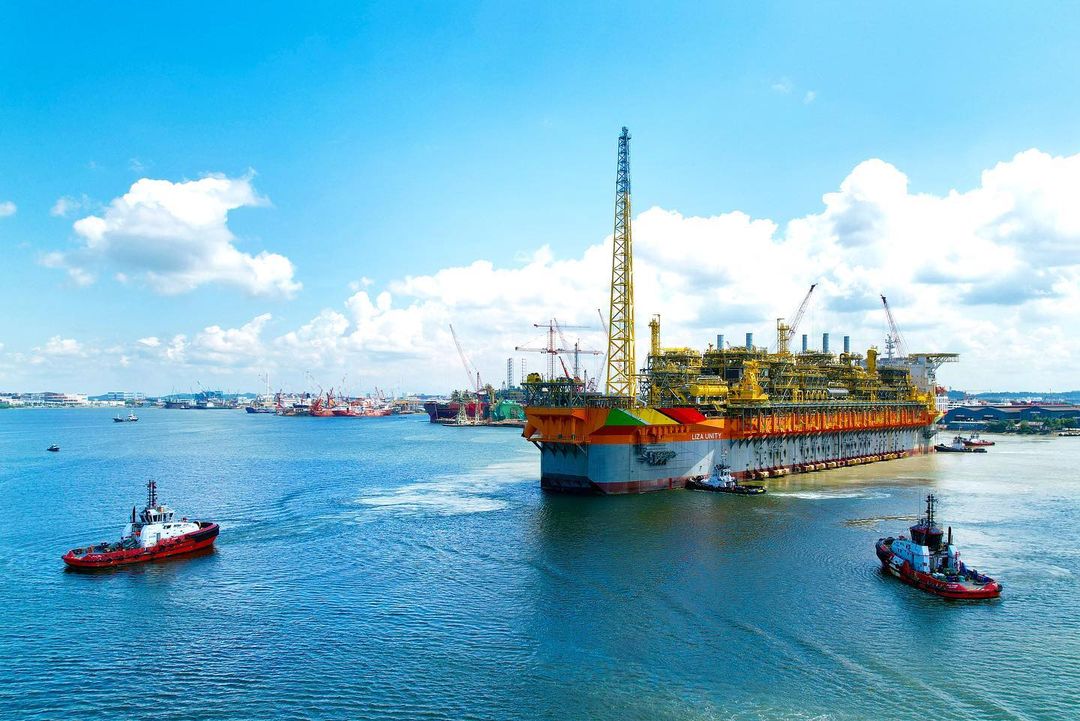
The Liza Unity is currently producing offshore Guyana, with production capacity of 220,000 barrels of oil per day (Photo: ExxonMobil Guyana)
Bolstered by ExxonMobil’s industry leading production and development pace in the Stabroek Block, Guyana’s oil and gas revenues are on track to break the US$1 billion mark this year and accelerate to US$7.5 billion annually in 2030, research by Rystad Energy shows.
The independent energy research and business intelligence company said on Friday that 2022 is set to be a turning point for the Guyana government to start capitalising on the vast reserves in the offshore field, with revenues more than doubling over 2021 levels.
As if the foregoing feats were not remarkable enough, especially during a time when host countries and oil explorers are faced with a confluence of economic aches from the COVID-19 pandemic and the Russia-Ukraine war, Rystad said Guyana continues to set itself apart with low break–evens and below-average emissions intensity. It said two notable factors will propel Guyana from a relatively small producer to a global leader in the coming years, solidifying the country’s position as a competitive and policy-friendly player for offshore production.
On an annual basis, Rystad said the government’s annual take from production is expected to increase to US$4.2 billion in 2025. Government revenue is then projected to fall to US$2.4 billion in 2027 on account of a projected drop in oil prices and continued spending on the Stabroek block’s development.
Still, the Norway-based group said production growth is set to accelerate, with revenue momentum resuming as new pre-Final Investment Decision (FID) projects are sanctioned and brought online, leading to peak government revenues of US$16 billion in 2036. Importantly, these projections do not factor in undiscovered resources.
In terms of ongoing projects, the Liza Phase 1 development, which began production in December 2019 utilising the Liza Destiny floating production, storage, and offloading vessel (FPSO) with a production capacity of approximately 120,000 gross barrels of oil per day, recently completed production optimisation work that expanded its production capacity to more than 140,000 gross barrels of oil per day.
The Liza Phase 2 development, utilising the Liza Unity FPSO, began production in February 2022 and is expected to reach its production capacity of approximately 220,000 gross barrels of oil per day by the third quarter.
The third development at Payara is ahead of schedule and now expected to come online in late 2023 utilising the Prosperity FPSO with a production capacity of approximately 220,000 gross barrels of oil per day.
The fourth development, Yellowtail, is expected to come online in 2025, utilising the ONE GUYANA FPSO with a production capacity of approximately 250,000 gross barrels of oil per day.
At least six FPSOs with combined production capacity of more than 1 million gross barrels of oil per day are expected to be in the Stabroek Block in 2027, with the potential for up to 10 FPSOs to develop gross discovered recoverable resources.
The Stabroek Block measures 6.6 million acres, ExxonMobil affiliate Esso Exploration and Production Guyana Limited (EEPGL) is the operator and holds 45% interest. Hess Guyana Exploration Ltd. holds 30% interest and CNOOC Petroleum Guyana Limited holds 25% interest.
Unfortunately, crime levels remain high. Armed robberies are a regular occurrence in shopping areas + Stabroek Market and other business districts in Georgetown. Guyana is not a safe place. Rape is on the rise.
Can Guyana partially substitute Russian gas? The numbers appear to say so

Arthur Deakin, Co-Director at Americas Market Intelligence Energy Practice.
By Arthur Deakin – OilNOW
In June of 2022, gas supply from Russia to the European Union fell by nearly two-thirds compared to the previous year. Nord Stream 1, which is responsible for nearly 40% of Russian gas exports to Europe, is currently shut down for a 10-day annual maintenance procedure. Questions are now arising whether Russia will extend that delay to further exert pressure on western Europe, a potential tactic by Putin to ratchet inflation and strain the public’s support for Russian sanctions.
Oil accounted for 10% of Russian GDP in the past five years, while gas represented a mere 2%. That makes a complete shut-down of Russian gas more likely, as indicated by Gazprom’s recent force majeure on the delivery of gas to some European suppliers. Even if the EU’s gas storage levels reach 90% by October 1, and Russian gas supplies are cut off, that stored capacity will only last until April 2023. Hence, a prolonged and cold 2023 winter will cause enormous economic and social consequences for the region, causing a massive rush towards the development of renewable energy and LNG export terminals across the world.
A big beneficiary of this “oil and gas rush” has been Latin America. Americas Market Intelligence (AMI) analysis shows that Peru has increased LNG exports to Europe by over 70% in the first half of 2022. In Mexico, after years of contentious policies aimed at hindering the private sector, AMLO has green-lit several public-private partnerships to develop offshore LNG hubs and export terminals. And perhaps most surprising of all, the U.S is now allowing Venezuelan oil to arrive in European markets.
Nearby in the Americas, Guyana has just unraveled 11 billion barrels of oil equivalent, the largest offshore oil discovery in the past decade. Although the final resource amount will likely be much larger, 20% of the proven reserves are estimated to be associated gas, equal to 13.2 trillion cubic feet (tcf). By those calculations, Guyana now has the third largest gas reserves in the region, behind Venezuela and Argentina.
It is still unclear how this newfound resource will be used. Most of it will be reinjected into the underground reservoir to optimize the extraction of oil. A small portion of it will be flared. And another small piece, equivalent to 50 million cubic feet per day, will flow through a 135-mile pipeline to the west bank of the Demerara River. Upon arrival, a Natural Gas Liquid (NGL) plant will create dry gas—used mostly to power a 300MW power plant—as well as other useful liquids such as ethane and propane.
Using Brazil’s most recent gas production data as a relative benchmark (given that they have similar gas reserves and associated gas), AMI estimates that Guyana would have a 51% surplus in gas production after accounting for gas reinjection, flaring, losses, and the gas-to-shore supply. That would mean that Guyana would be able to market 26.2 billion cubic feet (bcf) of gas per year, enough to replace 17% of Russia’s gas supply to Europe.
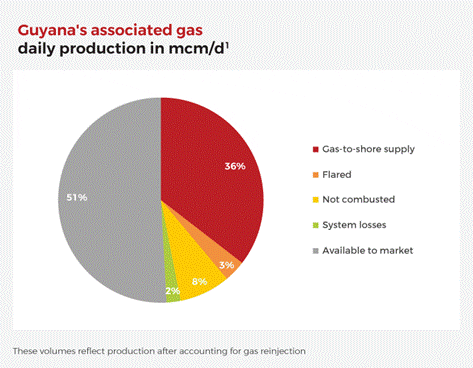
Source: AMI analysis
For this gas to reach Europe, there are several different alternatives that Guyana can pursue. Given Europe’s urgency and the relatively small size of these exports, an attractive option is New Fortress Energy’s “Fast LNG” solution, an offshore liquefaction and export facility that is developed in 18 to 20 months. In fact, the company has already signed several deals to develop these types of facilities in the Gulf of Mexico. Micro-LNG, or an onshore liquefication and export terminal, are also attractive options—but less so.
Although the current mindset is to “liquify, baby, liquify,” LNG export infrastructure and gas pipelines need to be built transition ready. Massive LNG supply projects, ranging from Qatar to Australia, will come online in the next few years. This means that these LNG projects, which have 30-to-40-year life spans, must also be equipped to transport low carbon fuels such as hydrogen, synthetic methane, and renewable natural gas. The EU, recognizing this need, has allowed gas projects to have a temporary “green taxonomy” if they have plans to switch to low-carbon fuels by 2035. This indicates that the gas infrastructure being developed now needs to match the future needs of the energy transition.
Climate activists are right to point out that gas projects are not the solution for a net-zero economy. Yet, in places like Guyana, where heavy fuel and diesel make up nearly 90% of the generation mix, gas can serve as a “transition” fuel and cut greenhouse gas emissions by up to 50%. This gas-to-shore plant will also reduce electricity costs by roughly 50%, fueling a manufacturing and economic boom that will benefit the local community. It is time for Guyana and its neighbors to capitalize on its abundance of resources, while simultaneously complying with climate targets.
About the Author
Arthur Deakin is Director of AMI’s energy practice, where he helps companies expand into Guyana and the wider Latin American region through market intelligence and analysis. Whether it’s conducting due diligence on local partners, sizing the market, or finding the most attractive risk-adjusted opportunities, AMI has led over 3,000 Latin American market studies since 1993 and has project experience in 20+ jurisdictions in the Americas.
The main shore base behind Guyana’s massive oil discoveries has seen tremendous growth
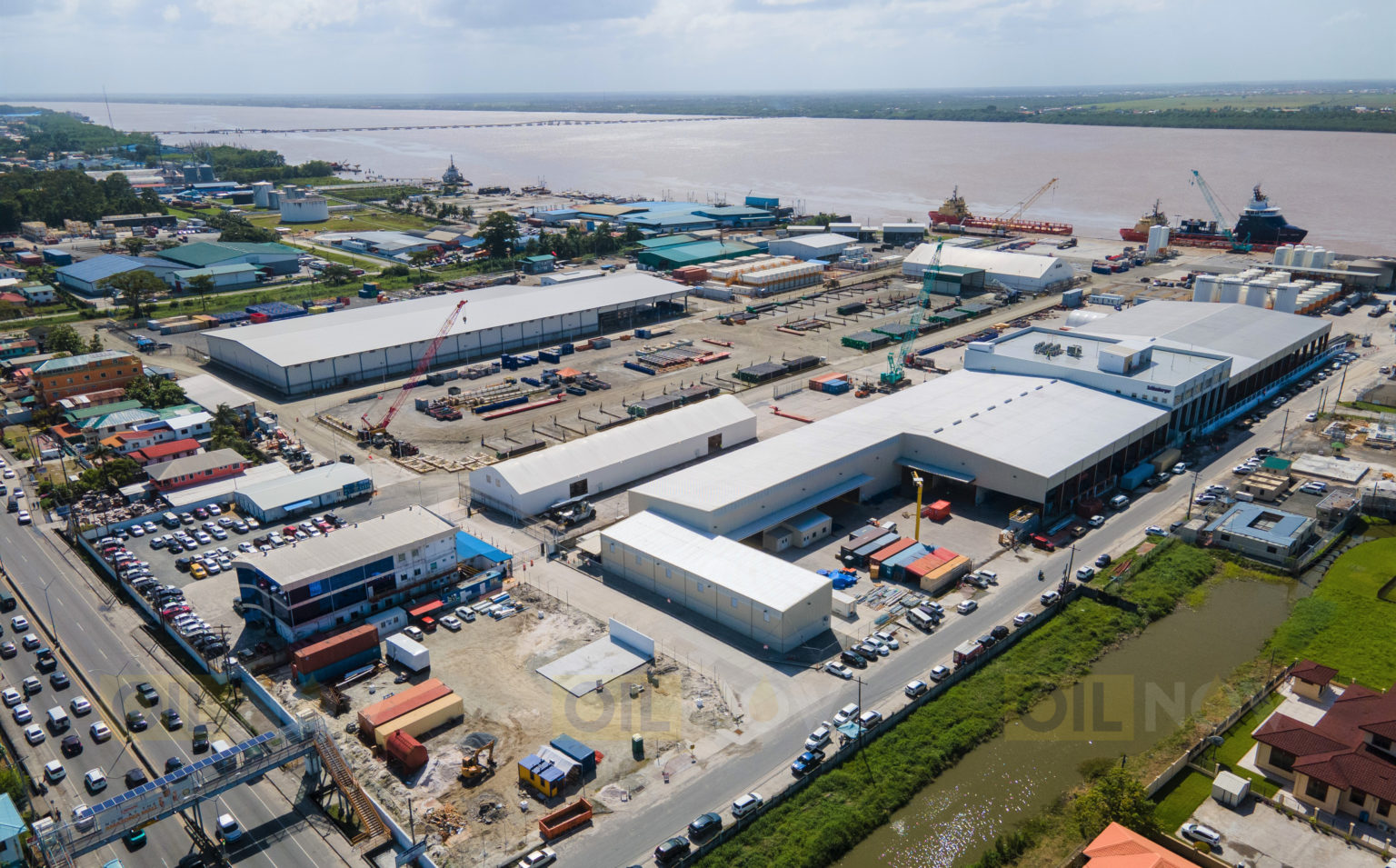
An aerial view of the Guyana Shore Base Inc.
ExxonMobil’s massive oil discoveries in Guyana led to the creation of the Guyana Shore Base Inc. (GYSBI) back in 2017 to service the rapidly increasing operations offshore.
It was the brainchild of four companies – Muneshwer’s Limited, TOTALTEC Oilfield Services, Pacific Rim Constructors, and LED Offshore Limited. Starting from scratch, GYSBI secured a five-year contract with Exxon, with only eight acres of land, two berths, and just one warehouse at Houston/McDoom on Guyana’s East Bank Corridor.
But now, five years on, the company’s growth has been tremendous, and it is now considered Guyana’s premiere shore base facility.
Deepwater action pushing major shorebase developments in Guyana | OilNOW
Its Executive Director, Robin Muneshwar shared at a recent contract signing ceremony that the company now occupies 170 acres with eight warehouses in total and four berths. It also has plans to further expand.
Added to that, Muneshwar said that GYSBI started out with five employees but now, has a workforce of 616 persons – 95% of which are Guyanese.
“What we have developed at GYSBI is something we are extremely proud of. Our safety record is unparallel, we have just celebrated two years of lost time injury free. Our operational record is excellent, so it was not handed to us. We have earned it,” he shared.
Guyana has emerged as one of the world’s most exciting hotspots for offshore crude oil exploration, with estimated recoverable resources of almost 11 billion barrels of oil equivalent thus far. But this is only the beginning and according to the GYSBI Executive Director, the company is building out its capacity further.
GYSBI recently teamed up with UTC Overseas – an international freight forwarding, and cargo logistics company headquartered in Houston, Texas – to offer operators project forwarding, warehousing, distribution and shore-based services, along with air, ocean and land transportation and customs clearance services.
It also recently acquired ISO 9001:2015 certification, in recognition of its efficient work processes and will also be commissioning two heavy lift berths later this year.
Guyana to be only country in region with critical oil spill capping equipment on hand – Bharrat
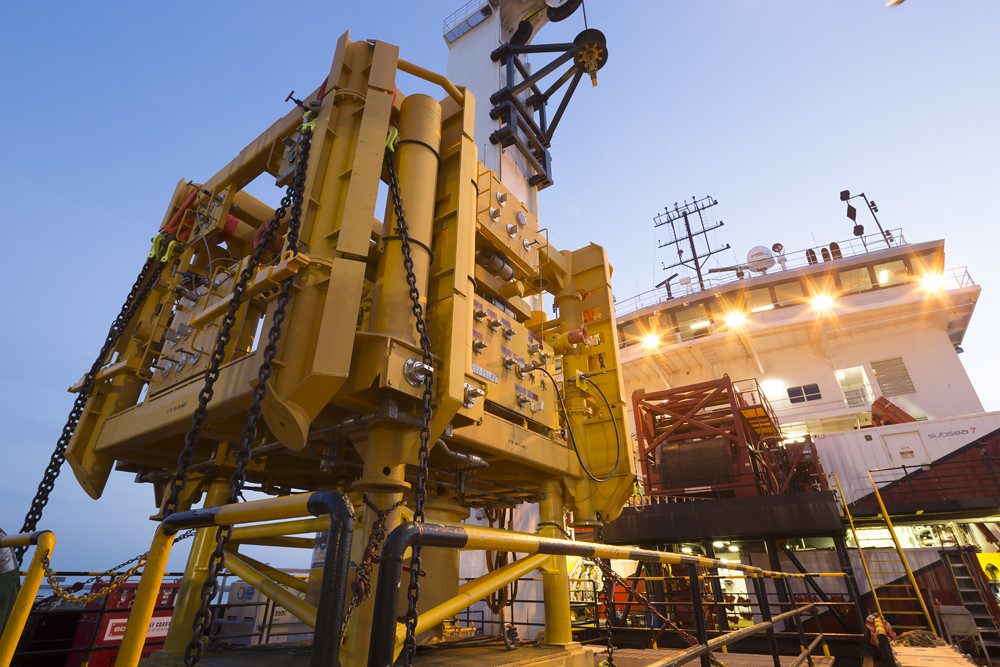
A Capping Stack
A key provision in ExxonMobil’s permit for the massive Yellowtail project offshore Guyana requires the company to have a capping stack maintained, tested, and stored in country. And this, according to Minister of Natural Resources, Vickram Bharrat, would make Guyana the only oil-producing nation in the region to have one readily available should there be a well blow-out miles offshore.
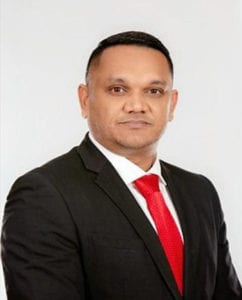
Vickram Bharrat
Pointing to other producers in the Latin America and Caribbean region, Mr. Bharrat said, “There is no other oil-producing nation around us – Trinidad [and Tobago] does not have a capping stack nor Brazil, or Suriname. Most of these countries pay the subscription and the capping stack is in Houston [Texas] or another part of the world.”
Capping stacks were created post the Gulf of Mexico, Macondo incident; it is placed over the blown-out well as a cap to stop or redirect the flow of hydrocarbons and to buy time for engineers to permanently seal the well. And these are not needed when drilling; they merely act as a centerpiece of a containment system kept in readiness at an onshore location, only deployed after the subsea blowout preventer failed to serve its purpose.
Soon, Guyana will have one on hand.
Mr. Bharrat explained that the country, like other oil-producing nations, also pays a subscription for the capping stack and will soon be able to save millions.
“What we are doing is establishing Guyana as a hub because if an oil spill occurs in any of those countries, we can also be affected. This capping stack could be deployed to any one of those countries should a spill occur. So, we brought that in country,” he stated.
Capping stacks are massive and can weigh as much as 50 to 100 tons, presenting logistical challenges in quickly transporting them to the emergency occurring at the blown-out offshore well. According to Mr. Bharrat, it would take at least 10 days to import the device.
That 10-day wait could be disastrous in the case of an oil spill.
Lending from banks increase as confidence in Guyana economy now at all-time high

The South American nation of Guyana has been benefitting from an influx of foreign and local investments in traditional and newer sectors. As a direct effect, an economic boom is currently underway, propelled by massive oil and gas resources found off the country’s coast. Now, President Dr. Mohamed Irfaan Ali has highlighted that the favourable economic environment has resulted in greater lender confidence in the economy.
In sharing statistics, the President stated during the opening ceremony of the International Building Expo on Friday that non-performing loans declined, moving from 11% in 2020 to 6.75% in 2022 – an improvement of 39%. Since he was addressing a building expo, the Head of State shared that total lending to the construction sector was GY$15.6 billion as of May 2022 – a 50% growth over two years.
Impressively, Dr. Ali related those total loans in the country grew by 20% in less than two years, amounting to GY$310 billion.
Booming economy gives Guyana easier access to financing for grid upgrade – expert | OilNOW
“That is the level of confidence that the people have in the economy,” he told the crowd on Friday evening. “What is more important is that mortgages grew by GY$16 billion or by 21%. That is the net effect of the programme that we are running. We will press a bit more on the accelerator in order to continue the aggression in the housing sector and other sectors.”
Government and leaders in the private sector have encouraged financial institutions to make more financing available to entrepreneurs to promote national development. Former Chief Economist of the Caribbean Development Bank, Dr. Justin Ram had said that a booming economy is the best time to access finance.
Guyana’s Senior Finance Minister, Dr. Ashni Singh, told a large delegation from Saudi Arabia earlier this month that government projects Guyana’s economy will grow 57.8% in 2022. This is 10 percentage points ahead of the government’s projection earlier this year, of 47.5%. Russia’s invasion of Ukraine and the resultant spike in the price of crude has been the major cause of this. Oil-producing nations benefited from this scenario as prices have stayed above US$100 per barrel for several months.
Guyana is open for business – 55 areas ripe for investment | OilNOW
As the country continues to expand at an unprecedented rate, Guyana’s Chief Investment Officer Dr. Peter Ramsaroop said recently, “If you are an investor in the developed world and you start paying attention to the [global] depression you’ll ask, ‘Where do I put my next set of money?’ Then Guyana becomes that next important destination. We are going to keep expanding… The future for Guyana is well-defined for the next few years.”
He said Guyana as one of the premier investment spots in Latin America and the Caribbean.
Guyana oil revenue projections soar to US$157 billion by 2040, Rystad Energy analysis shows
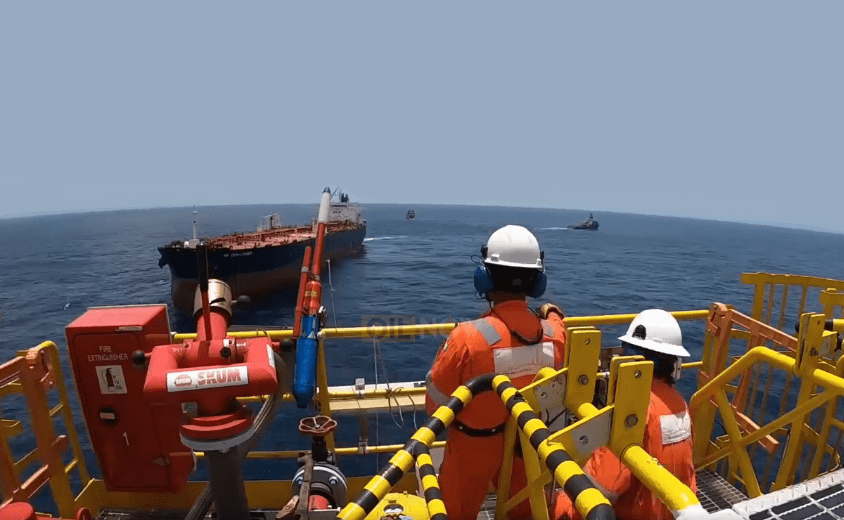
Crew onboard the Liza Destiny FPSO offshore Guyana prepare for an approaching oil tanker.
The recent spate of prolific discoveries in the Stabroek Block and the steady pace of Final Investment Decisions (FID) are positioning Guyana to reap the rewards of these finds with cumulative revenues totaling US$157 billion by 2040. This is according to independent research consultancy group, Rystad Energy.
In its latest analysis of one of the world’s fastest growing economies, Rystad Energy said its review of the revenue stream to come for Guyana is simply astounding.
Schreiner Parker, Senior Vice President and Head of Latin America and the Caribbean commented that Guyana is just starting to extract and monetise its vast resource wealth, adding that the coming years will be a financial windfall for the Georgetown government. “The country has played the long game after several decades of elusive exploration. But the country’s offshore production is finally ready to take off,” says Parker.
Exxon confirms 1.2 million barrels per day capacity for Guyana by 2027 | OilNOW
While Guyana is poised to enter the proverbial big league this year, Rystad still cautioned that the administration must not lose sight of the fact that managing these overwhelming resources may not be all plain sailing.
The Norwegian group said strong institutional governance, transparency and regulatory practices will be vital to unlocking the full potential of Guyana’s resource wealth for its society.
“Although the government has taken steps to improve governance, including establishing a sovereign wealth fund and improving fiscal policy transparency, there are still improvements to be made,” expressed the group.
As an example, Rystad Energy noted that the Extractives Industries Transparency Initiative (EITI), which champions strong resource management and governance practices, recently found several weaknesses in Guyana’s company reporting and tax processes. However, their EITI score of 52 points will likely grow in the coming years as recent improvements take effect, the business intelligence group stated.
Guyana gets “fairly low overall score” in implementing 2019 EITI Standard | OilNOW
The EITI Board has since determined that Guyana will have until the next validation process commencing on April 1, 2024, to carry out 32 corrective actions to improve its score.
On Tuesday, ExxonMobil announced two more discoveries offshore Guyana, bringing the total oil strikes made since 2015 to 33, according to the Ministry of Natural Resources.
CGX may find oil in Guyana in the year 3475. That may be the same year that Guyana finally becomes rich. CGX is Guyana. Both will do, shall become, plan to do, going to do, is going to become and is on the verge of.
Guyana has enough gas to replace 17% of Russia’s supply to Europe – AMI analyst
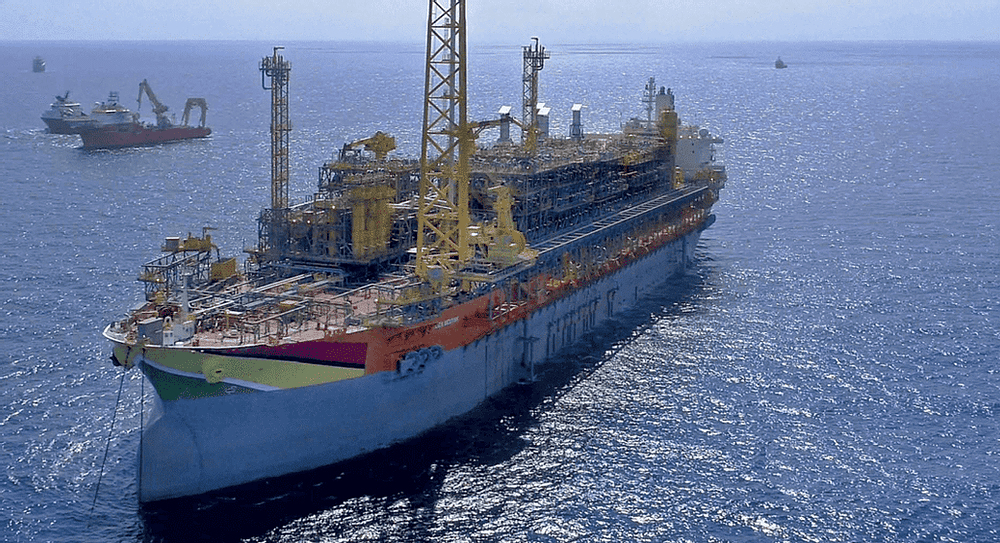
The Liza Destiny FPSO, one of the vessels producing oil and gas offshore Guyana.
Guyana has delivered around 11 billion barrels of oil equivalent since 2015, the largest offshore oil discovery in the past decade, with the potential to replace at least 17 percent of the gas supply lost to Europe due to the Russia-Ukraine war, now in its sixth month. This is according to Arthur Deakin, Director of Energy Practice at Americas Market Intelligence (AMI).
In his latest column, Deakin said 20% of the proven reserves are estimated to be associated gas, equal to 13.2 trillion cubic feet (tcf). By those calculations, he said Guyana now has the third largest gas reserves in the region, behind Venezuela and Argentina.
Noting it is still unclear how all of this newfound resource will be used, he shared that most of it will be reinjected into the underground reservoir to optimise the extraction of oil. Deakin further stated that a small portion of it will be flared. And another small piece, equivalent to 50 million cubic feet per day, will flow through a pipeline to the west bank of the Demerara River. Upon arrival, a Natural Gas Liquids (NGL) plant will create dry gas—used mostly to power a 300MW power plant—as well as other useful liquids such as ethane and propane. This is all part of the Guyana government’s plan to introduce a gas-to-energy plant circa 2025.
Using Brazil’s most recent gas production data as a relative benchmark (given that they have similar gas reserves and associated gas), AMI, he said, estimates that Guyana would have a 51% surplus in gas production after accounting for gas reinjection, flaring, losses, and the gas-to-shore supply. The analyst said this would mean that Guyana would be able to market 26.2 billion cubic feet (bcf) of gas per year, enough to replace 17% of Russia’s gas supply to Europe.
For this gas to reach Europe, Deakin said there are several different alternatives that Guyana can pursue. Given Europe’s urgency and the relatively small size of these exports, he proffered that an attractive option is New Fortress Energy’s “Fast LNG” solution, an offshore liquefaction and export facility that is developed in 18 to 20 months. In fact, the company has already signed several deals to develop these types of facilities in the Gulf of Mexico. Micro-LNG, or an onshore liquefication and export terminal, are also attractive options—but less so.
Given the foregoing, Deakin alluded that Guyana has a lucrative export opportunity while being able to reduce electricity costs by roughly 50% and fueling a manufacturing and economic boom that will benefit the South American country.
Deakin believes it is time Guyana capitalises on her abundance of resources, while simultaneously complying with climate targets.
The fact is after 7 years, Guyana still does not have any insurance coverage.
Is it not the negligence of the PPP Gov't who entered into an agreement of this nature and ignored the requirement of Insurance?
New oil producer wants to maximise value in forestry, mining, tourism industries

The Kaieteur Falls in Guyana
With Guyana’s oil revenues projected to peak at US$16B in 2036, President, Irfaan Ali has said that a significant portion of these profits will be used to maximise the value and sustainability of industries such as forestry, mining, and tourism.
According to the government’s Low Carbon Development Strategy (LCDS) 2030, funds are expected to help with the implementation of sustainable forest management programmes, including finalising and implementing the Voluntary Partnership Agreement (VPA) under EU-Forest Law Enforcement, Governance and Trade (FLEGT). This is expected to enable Guyana to effectively trade with the European Union and other markets by the issuance of FLEGT licences.
It will also assist in the implementation of the Programme for Endorsement of Forest Certification (PEFC) so as to boost local and international trade of certified forestry products.
Plans are also in the pipeline to maximise value creation of forest products while exploring market opportunities for exports. The document notes that progress has been made with Barbados, Ghana and other countries. For example, 120 prefab houses are being manufactured using local wood and exported to Ghana.
With respect to mining, government intends to implement mineral mapping in the mining districts to identify economically exploitable deposits as a means of improving productivity within the sector.
The document also notes the government’s intent to advance transparency, meet commitments on the phase-out of mercury and implement education and incentives for integrated planning and management of the mining and forest sectors. The purpose of these measures is to increase the sector’s ability to grow sustainably and in particular to play a role in serving increased global demand for rare earth metals, which are essential to the global energy transition because of their use in electric vehicles, solar and other important parts.
As for Guyana’s Tourism Strategic Plan, this is currently being drafted, drawing on previous work and being updated to align with the LCDS 2030. At the same time, work is progressing on the provision of tourism infrastructure, especially hotels, in Georgetown and along the coast.
Between 2022 and 2025, LCDS 2030 states that over 2,000 hotel rooms will be added, many of which will be operated by global brands which will increase the visibility of Guyana’s tourism product.
Government has also invited expressions of interest for the establishment of eco-lodges. It anticipates that this will result in a number of major investors working with local communities all while being in keeping with its goal to steer the nation clear of a tunnel-vision approach to oil development.
Guyana will be among the top five elite global offshore producers by 2035 – Rystad Energy
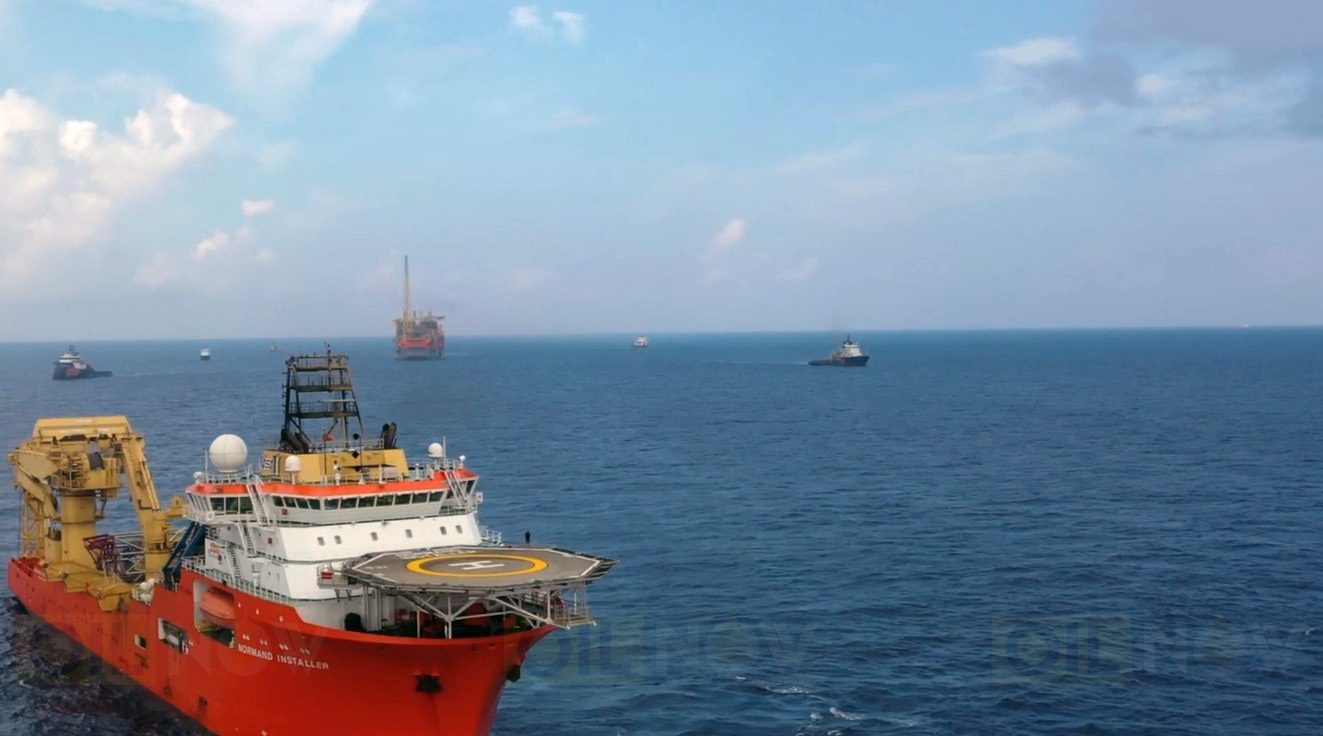
An SBM Offshore vessel conducting installation work offshore Guyana for the Liza Unity FPSO.
With ExxonMobil and partners fast-tracking exploration and development projects in Guyana, the country is set to rank in the top five-list of elite global producers by 2035. This is according to Rystad Energy, an independent energy research and business intelligence company headquartered in Norway.
In its recent analysis, Rystad said Guyana was already proving its potential to be a fierce global competitor as it emerged at the top of the leaderboard for most offshore discoveries since 2015 with 11.2 billion barrels of oil equivalent, amounting to 18% of discovered resources and 32% of discovered oil.
Of that total, Rystad Energy said a whopping 9.6 billion barrels consist of oil, far outpacing the United States in second place, with a comparatively small 2.8 billion barrels. It notes that the Stabroek block accounts for all of these finds, but recent discoveries in other areas show the potential for growth elsewhere.
The Norwegian group said Guyana is now forecast to produce 1.7 million barrels per day (bpd) of oil by 2035 – not accounting for as-yet undiscovered volumes – propelling the country to the fourth position on the list of the largest global offshore oil producers. At that pace, the country leapfrogs the US, Mexico and Norway.
Earlier this year, Rystad Energy’s Latin America analyst, Sofia Forestieri, said that Guyana was on track to become the second largest deepwater producer in the world. The only deepwater producer Rystad Energy expects to be above Guyana by then is Brazil, that will be producing close to 5 million barrels of oil per day.
And Guyana’s oil is set to outlast that of many other deepwater producers because of two main factors – quality and cost to produce.
Exxon will have the capacity to produce 1.2 million bpd by 2027 and sees potential for up to 10 floating production, storage and offloading (FPSO) vessels offshore Guyana this decade.
ExxonMobil’s subsidiary, Esso Exploration and Production Guyana Limited (EEPGL) also plans to drill 60 exploration wells over the next six years, pending regulatory approvals.
‘One Guyana’ FPSO takes SBM Offshore’s order book to record US$31.1B – CEO

The One Guyana FPSO hull.
BM Offshore’s order book hiked to a record-breaking US$31.1 billion when it secured the contract to construct the massive ‘One Guyana’ floater for ExxonMobil’s Yellowtail development.
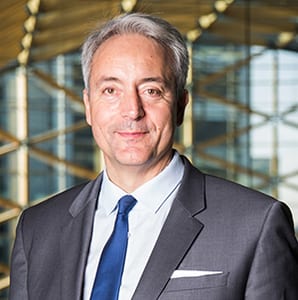
Bruno Chabas, CEO of SBM Offshore
This much was told to shareholders by SBM Offshore’s Chief Executive Officer (CEO) Bruno Chabas during the company’s half-year earnings call.
Chabas said that SBM Offshore expects to deliver around US$9 billion in net cash flow from its Lease and Operate backlog during the period which gives visibility on cash flow for the next 28 years.
SBM Offshore’s market outlook for new floating, production, storage, and offloading (FPSO) vessels remains “positive” as the world requires energy that is not only sustainable but affordable and reliable.
‘One Guyana’ will deliver biggest daily production for new oil nation | OilNOW
The ‘One Guyana’ is based on SBM Offshore’s Fast4Ward® program that incorporates the company’s new build, multi-purpose floater hull combined with several standardized topside modules.
The vessel is being designed to produce 250,000 barrels of oil per day, with an associated gas treatment capacity of 450 million cubic feet per day and water injection capacity of 300,000 barrels per day. The floater will be spread moored in water depth of about 1,800 meters and will be able to store around two million barrels of crude oil.
Already, the hull for the floater has been completed and is sitting in Indonesian waters, waiting to travel to the Keppel shipyard in Singapore for assembly.
The project’s turnkey phase is being executed in conjunction with United States engineering and construction company, McDermott, under a special purpose company. In it, SBM Offshore holds 70% and McDermott 30% equity ownership. But the FPSO will be fully owned by SBM offshore.
And with the introduction and ramp-up of Yellowtail, production offshore Guyana would peak at 830,000 bpd, barring further optimization work by ExxonMobil.
Meanwhile, on the SBM Offshore’s earnings, the company expects full-year core earnings (EBITDA) to land at above US$950 million and revenue to come in at about US$3.2 billion.
“Our teams continue to deliver solid results, despite the challenging environment. On our overall project portfolio, strategic mitigating measures against inflation have been proving effective on controlling cost and protecting schedule. The overall profitability of the project portfolio remains robust,” the SBM Offshore CEO said.
Guyana will need 160,000 more workers to sustain its oil-driven economic growth – Migration Policy Institute

Workers at a construction site in Guyana.
Guyana’s economy grew 43.5% in 2020. Government expects that it will grow 57.8% in 2022. This growth requires a labour force that can meet the needs of an emerging economy.
The Migration Policy Institute estimated that Guyana will need at least 160,000 more workers to sustain the economic growth brought on by the exploration for and development of its oil and gas resources. It expects most of this lot will have to be sourced from overseas.
It said even if the country were to harness all unemployed, underemployed, and discouraged Guyanese workers, domestic supply would only amount to 63,500 workers. The institute explained that the International Organisation for Migration (IOM) had said Guyana will need to attract a minimum of 100,000 workers to realise its full growth potential.
Guyana seeks more diaspora involvement in advancing oil & gas economy | OilNOW
The Migration Policy Institute discussed the various complexities of Guyanese society where migrants are concerned. This includes the decades-long continuous exodus of skilled talent to developed countries, that drained the South American nation of vital human resources. It also includes an influx of Venezuelan migrants due to the recent economic collapse of the Bolivarian Republic, and of skilled citizens of the Caribbean Community (CARICOM) who qualify to move and work freely.
Accordingly, the Institute said these are the groups Guyana should look to, to eliminate its coming labour shortfall.
“Guyana lacks a comprehensive migration policy to address evolving migration trends and meet the country’s needs,” the institute said. It also pointed to IOM advice that Guyana establish an information centre to conduct labour market and skills gap analyses regularly, taking stock of the skillsets of migrants already in the country.
Guyana has put a lot of effort into attracting its diaspora, through holding conferences and other events, as well as offering special incentives to reintegrate them upon their return.
The country will continue to see rapid growth as a result of oil and gas, as new projects come on in this decade. However, government intends to facilitate growth of several sectors alongside oil and gas, to ensure its economy diversifies and is not vulnerable to oil price fluctuation.
Guyana has earned over US$1.2 billion since oil production started – nearly half its 2022 budget

A tanker lifting crude from an FPSO offshore Guyana.
The Natural Resource Fund, established to receive revenues from oil sales and royalties, has received more than US$1.24 billion since first oil in December 2019.
This scale of revenue flow is significant for Guyana, since from this single sector, these revenues are almost equivalent to half of the country’s 2022 budget which Finance Minister, Dr. Ashni Singh, presented at US$2.65 billion (GY$552.9 billion) in January.
Of the amount received into the Fund, the government has withdrawn approximately US$400 million to support Guyana’s infrastructure-heavy 2022 budget. The withdrawal was done in two US$200 million tranches. The National Assembly approved the withdrawal of approximately US$607 million from the Fund in February. So, the government is expected to withdraw the remaining approved balance before the year is out.
In July alone, the Fund earned GY$10.646 billion in royalties and GY$50.127 billion in profit oil, totaling approximately GY$60.773 billion (US$291.477 million).
As a result of the withdrawal of the second tranche in July and the deposits made into the Fund, its balance as at July 31 is GY$176.3 billion (US$845.6 million). This includes profit oil revenues, royalties, and interest.
It took Guyana a little over 2.5 years to receive US$1.2 billion from oil, but with production increases, Guyana’s annual take will be a lot more. The Liza Phase 1 project had been the lone producing project at 120,000 barrels per day (b/d) up until earlier this year. Optimisation work increased its production capacity to 140,000 b/d and the coming onstream of Liza Phase 2 tripled production levels to a peak of approximately 365,000 b/d. This, paired with high oil prices experienced for much of 2022, is expected to earn Guyana more than US$1 billion this year alone.
Budget 2022, as presented at the start of the year, indicated an estimate of about US$957 million from oil. But this was before Russia invaded Ukraine and the price of crude shot up to and was sustained well over US$100 a barrel for months. As a result, Guyana’s projected economic growth for 2022 shot up 10 percentage points from 47.5% to 57.8%.
Guyana can expect even more in annual revenues as new projects come online. Payara in 2023 will take production levels to 580,000 barrels per day. Yellowtail in 2025 will make Guyana the world’s largest per capita producer.
While new projects will increase Guyana’s annual revenues, the country’s share of oil production will increase after ExxonMobil and its partners recover the funds spent exploring and developing the Stabroek Block.
ExxonMobil, the operator, plans to have six producing vessels offshore Guyana by 2027, with total capacity exceeding 1.2 million barrels per day. Further ahead, the operator envisions 10 producing vessels operating the Stabroek Block.
Guyana on ‘right track’ accelerating oil and gas development to fund energy transition – Rystad Energy
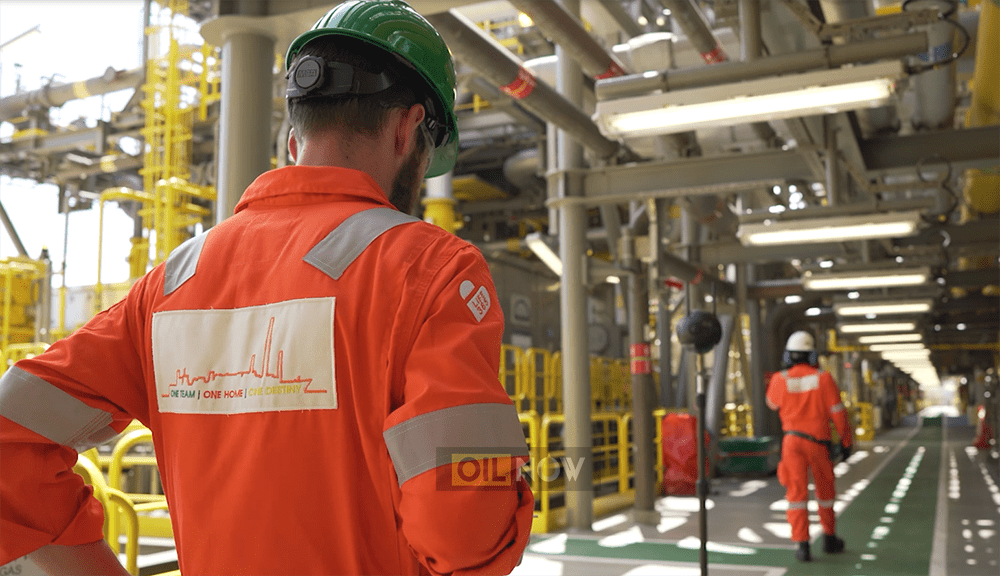
Crew members on board the SBM Offshore built and operated Liza Destiny FPSO moored offshore Guyana where it is producing oil at the Liza Phase 1 Development.
Norway’s Rystad Energy has lauded Guyana’s efforts to implement the right policies to attract foreign investment that will essentially fund its transition to cleaner, greener energy.
In its August Review, Rystad Energy even urged that other Latin American nations use Guyana as “the blueprint” for energy policies aiming to attract foreign investments in the region.
Guyana on track for optimal use of oil windfall in energy transition – IDB Report
Guyana has been attracting major attention since ExxonMobil’s first oil discovery in the massive Stabroek Block in 2015. And since then, other oil-producing nations have been introducing new regulatory frameworks to make their business environments more attractive.
Guyana’s Production Sharing Agreement (PSA) with ExxonMobil, considered by some critics as too generous, is what is spurring aggressive development investments, that are consistent with the government’s transformative agenda.
Guyana needs 10 FPSOs; renegotiation would kill the momentum – Dr. Jagdeo | OilNOW
Within the last two quarters, ExxonMobil has upped Guyana’s resource count to 11 billion barrels of oil equivalent. It has two oil platforms currently in operation and has its eyes set on 10 by the end of the decade.
But Guyana’s energy goals are still in play. The country is at net zero and is working to transition away from fossil fuels with its upcoming gas-to-energy project. Also in the pipeline are massive solar farms along with its trademark Amelia Falls Hydro-project.
Columbia’s case
Compared to Guyana, Research Director for Latin America, Daniel Leppert said Columbia is heading in the opposite direction. Its President, Gustavo Petro introduced a new tax reform to fund social spending. According to Rystad Energy, the reform aims to bump up taxes on oil exports – which account for 30% of Columbia’s total exports.
Large number of ships heading to South America, Caribbean with refined products
President Petro has reportedly made “bold statements” on abandoning Columbia’s dependence on oil and gas – 12% of its total income flows alone for 2021. But with an economy and energy matrix that is highly dependent on fossil fuels, Rystad Energy said President Petro “walks a fine line” with its new tax reform. Rystad Energy argues such reform can harm much-needed investments in the sector that is capable of helping the country with energy security and could be the main source of funding for the energy transition.
“Colombia’s hydrocarbon sector has seen better days, and if investments are deterred, the consequence on the economy will surely be felt,” Rystad Energy pointed out.
The Petro-led administration’s objectives on the energy transition and renewables are necessary. However, it needs to blend with energy security, affordability, and access, Rystad Energy said. And with Columbia’s energy matrix that is more than 60% reliant on fossil fuels, Rystad Energy said it would be a hard task to implement a fast-paced transition capable of reconciling affordability and security.
“In that sense, it has been encouraging thus far to see a country like Guyana implement the necessary regulation and governance to attract foreign investors. The country is speeding up the development of its offshore hydrocarbon resources to not only develop its economy but also fund the energy transition,” Rystad Energy said. “Time will only tell whether the country enjoys the necessary long-term stability, but there is no question on whether Guyana is currently on the right track.”
Exxon’s costs subject to scrutiny by partners, Guyana government and third parties
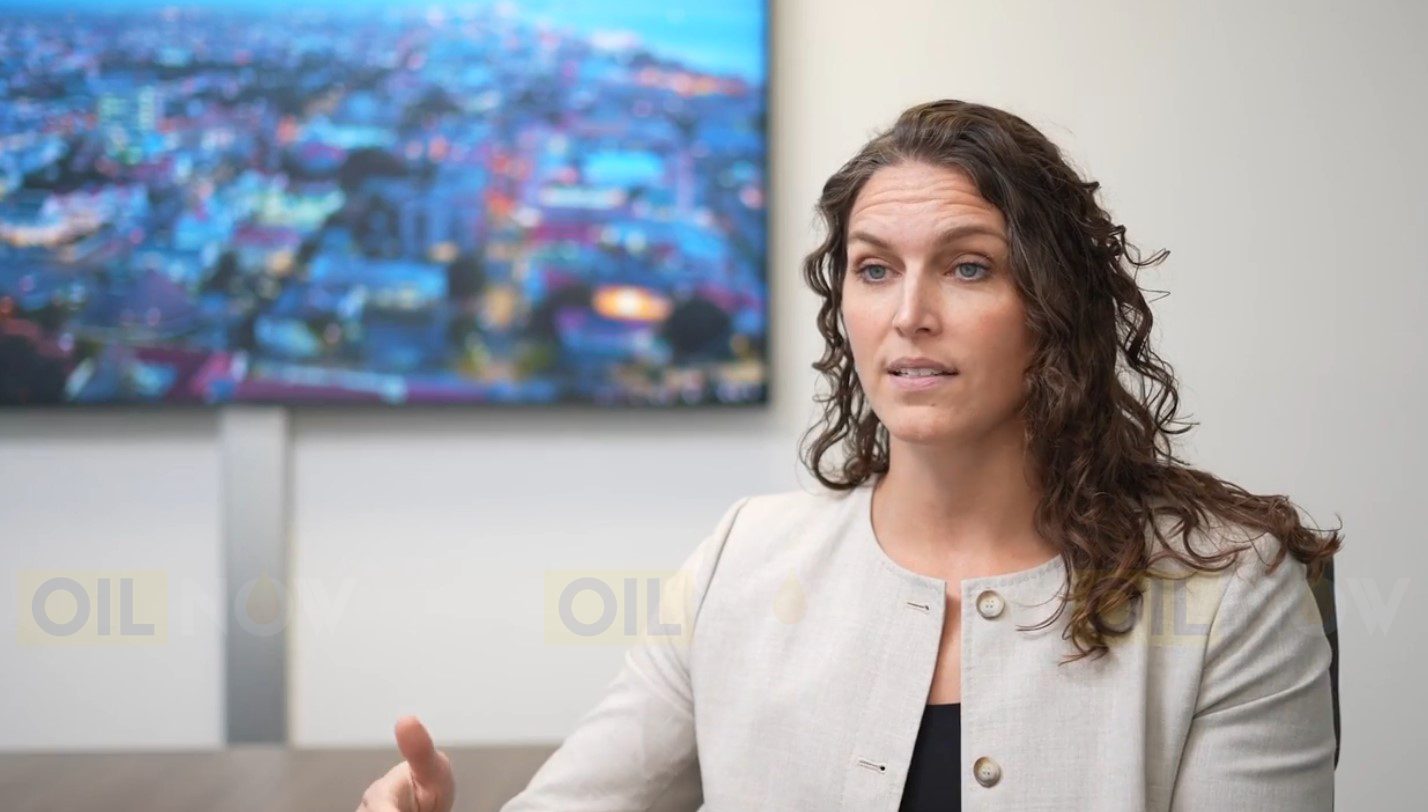
ExxonMobil Guyana’s Treasurer, Katrina Masters
Officials at ExxonMobil Guyana say a layered system of reviews and audits are in place to ensure the integrity of the expenses that go into its cost bank.
They made the comments during the 26th episode of Access ExxonMobil, published on Tuesday. The company dedicated the episode to answering frequently asked questions about the Stabroek Block Production Sharing Agreement (PSA) and its operations.
On the matter of costs, ExxonMobil Guyana President, Alistair Routledge said the company’s co-venturers – Hess and CNOOC – conduct audits of its finances. They hold 30% and 25% interest in the Stabroek Block, respectively, while Exxon holds 45%. Because they are co-managers on the license and invest funds alongside Exxon, they have audit rights.
In addition to the co-venturers, ExxonMobil Guyana’s Treasurer, Katrina Masters said third party auditors also audit the company’s financial statements. Those statements are filed and made public.
Routledge said the Guyana government also has a review process in place. He said estimated costs are budgeted annually, and ExxonMobil reports its costs on a monthly basis to the government.
“Then ultimately, the government also has audit rights to come in and audit all of our expenditures,” Routledge said.
The most recent one concerns the audit of the Stabroek Block consortium’s 2018-2020 costs. The Government hired a consortium of local and foreign auditors in May, with a contract valued at US$751,000. The consortium consists of Ramdihal and Haynes Chartered Accounting and Professional Services Firm, Vitality Accounting and Consultancy Inc., and Eclisar Financial & Professional Services. They will be partnering with the Oklahoma-based Martindale Consultants Inc. and the Swiss technical company, SGS, which is leading the project. The contract includes provisions for knowledge transfer, so that ultimately, Guyanese firms will be able to conduct cost audits on their own.
The Stabroek Block partners have invested tens of billions of US dollars in exploring and developing hydrocarbon resources offshore Guyana, which since 2015, has amounted to an estimated 11 billion barrels of oil equivalent.
ExxonMobil has drilled many exploration wells, amounting to 33 commercial discoveries, according to the Guyana government. The company plans to drill about 40 more wells through 2028.
The partners have invested in developing four projects so far. Liza Phase 1 carried a cost of US$3.6 billion – 4 billion. Liza Phase 2 cost US$6 billion. Payara is costing US$9 billion. Yellowtail will carry a total cost of US$10 billion. The partners also pay operating costs for these projects.
The partners see potential for as many as ten floaters operating offshore Guyana by the end of the decade, which will require tens of billions more in investments.
US, Norway, Guyana, and Angola were biggest suppliers of additional crude to UK in June
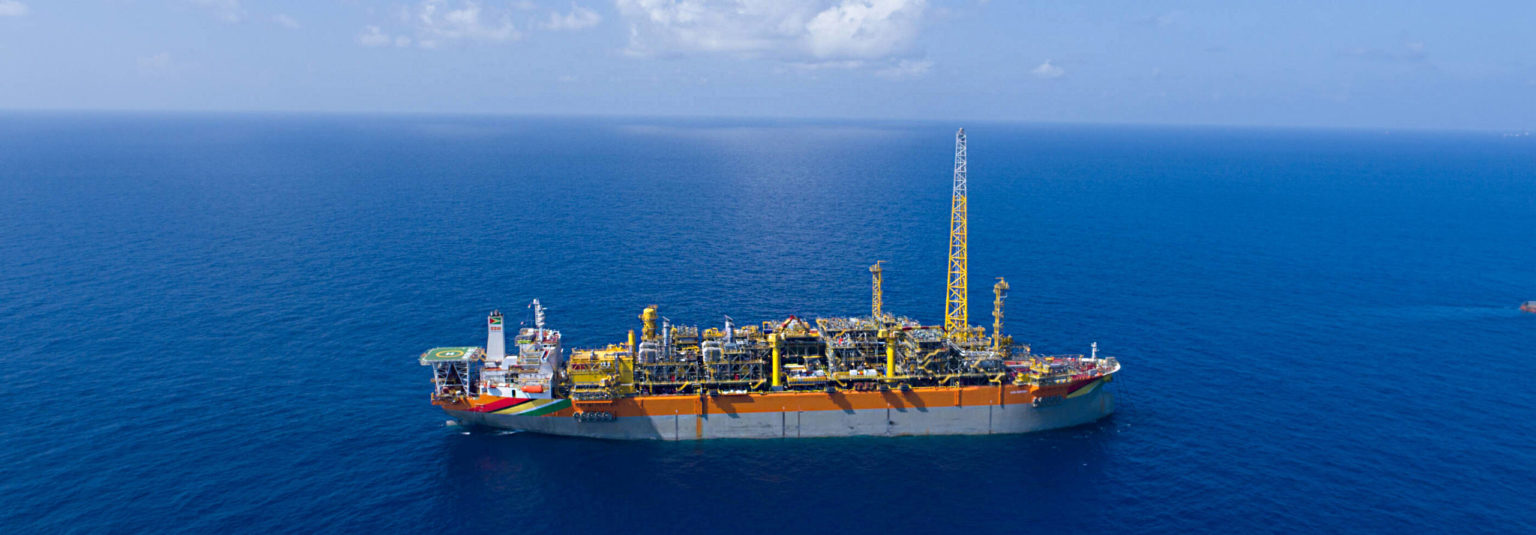
The UK imported no crude oil or refined products from Russia in June for the first time on record, according to UK trade data. S&P Global Platts said in an August 24 article that this follows phased sanctions on imports of Russian oil over the invasion of Ukraine.
According to Platts, prior to Russia’s February 24 invasion of Ukraine, it was the UK’s largest supplier of refined oil in 2021, accounting for 24.1% of all imports, also supplying 5.9% of the UK’s crude oil imports, and 4.9% of the UK’s gas imports.
Norway group warns war in Ukraine could wipe out 1 million barrels per day of oil demand
For the 12 months to February 2022, the value of Russian fuel imports had averaged GBP499 million ($589 million), according to the Office for National Statistics data.
“The US, Norway, Guyana, and Angola were the biggest suppliers of additional crude to the UK in June compared to pre-war levels, the data showed, with a combined additional value of GBP1.04 billion,” Platts sated.
Guyana’s daily production hit an all-time high of 386,000 barrels in July with the combined output from the Liza Destiny and Liza Unity FPSOs, ExxonMobil’s first two projects offshore the South American country.
By 2027, Exxon is set to ramp up production at the Stabroek Block to around 1.2 million barrels of oil per day. This will make Guyana the highest per capita oil producer in the world.
Guyana seeking advisory services for transformational Gas-to-Energy project
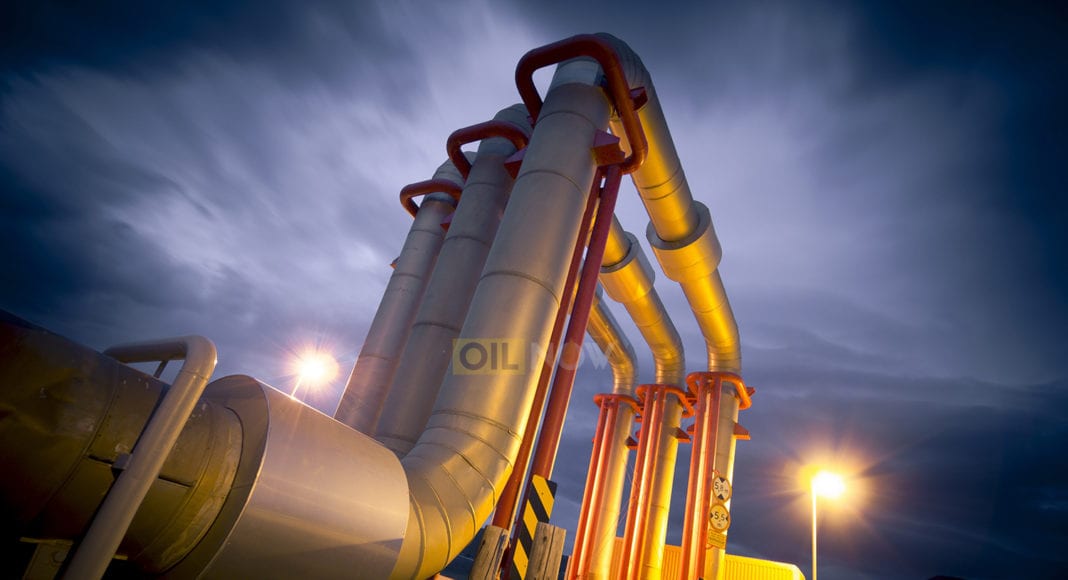
With Guyana’s massive Gas-to-Energy project on track for its 2024 start-up, the government through a request for proposals (RFP) is seeking consultants to provide legal and commercial advisory services along with negotiation support.
The RFP published by the Ministry of Natural Resources read that the objective of the assignment is for the eligible consultant to provide legal and commercial advisory services and negotiating support to the Government of Guyana (GoG), through the Ministry and the Gas-to-Energy Task Force.
These services directly concern the Gas Supply Agreement (GSA) and associated agreements during project development.
Interested consultants can get more information from the Ministry of Natural Resources and should submit proposals by September 13, 2022, to Guyana’s National Procurement and Tender Administration Board (NPTAB).
Guyana’s government has been pushing the project, which is expected to cut the cost of power by at least 50% for Guyanese households. President Dr. Mohamed Irfaan Ali said that the project has undergone every test of scrutiny, including environmental and financial feasibility, and has passed. The President said it is time for this project to move forward.
Government is also seeking a Gas-to-Energy project manager. Government means for the Natural Gas Liquids facility and the power plant to be constructed together to save on costs.
The construction of these facilities is being spearheaded by the government of Guyana, while ExxonMobil is handling the construction of the pipeline. The oil major has already started the tender process for the construction of the onshore pipeline.
The project is expected to transport 50 million cubic feet of gas per day in its first phase from Exxon’s Liza field. This will be the source for 250 megawatts (MW) of power for the country’s main grid and enough natural gas liquids to meet other domestic needs.
Accelerated oil development pushing growth in tourism, mining, construction sectors – Report

The rapid expansion of Guyana’s oil and gas industry is also propelling growth in its mining and construction sectors. In this regard, the country’s Ministry of Finance outlined in its 2022 Half-Year report that the mining and quarrying industries are estimated to have expanded by 36.3% in the first half of the year.
OilNOW understands that sand output, based on surveys, is estimated to have expanded by 19.8%, on account of increased demand from the construction industry. In fact, the construction sector is now projected to grow by 19% in 2022 given the magnitude of housing and other development projects that will be needed to support oil’s domino effect on the economy.
Guyana oil boom will drive construction activity, reduce unemployment – Fitch Solutions | OilNOW
Services also saw expansion totaling 7.6% in the first half of the year. The government explained that expansion in the sector was mainly driven by the wholesale and retail trade, and transport and storage industries, which grew by 17.2% and 13.6% respectively, during the first half of the year. It explained that increased wholesale and retail trade activity was largely driven by the expansion in the construction industry and the corresponding growth in demand for building materials.
Growth in the transport and storage sector was mainly attributed to increased demand for haulage and warehousing for the oil and gas sector. Services are now expected to grow by 6.3% this year.
Despite being challenged by the COVID-19 pandemic, the government was keen to note the bump in tourism sector revenues which it attributed to the oil and gas sector.
Notwithstanding the pandemic, government said there was a 103% increase in visitor arrivals from January to May 2022 from 48,626 to 105,905, when compared to the same period in 2021. A further 158,223 additional arrivals are expected in the second half of 2022, coinciding with Guyana’s hosting of the finals of the Caribbean Premier League.
JOB FAIR! VEHSI recruiting Region Three residents for shore base project
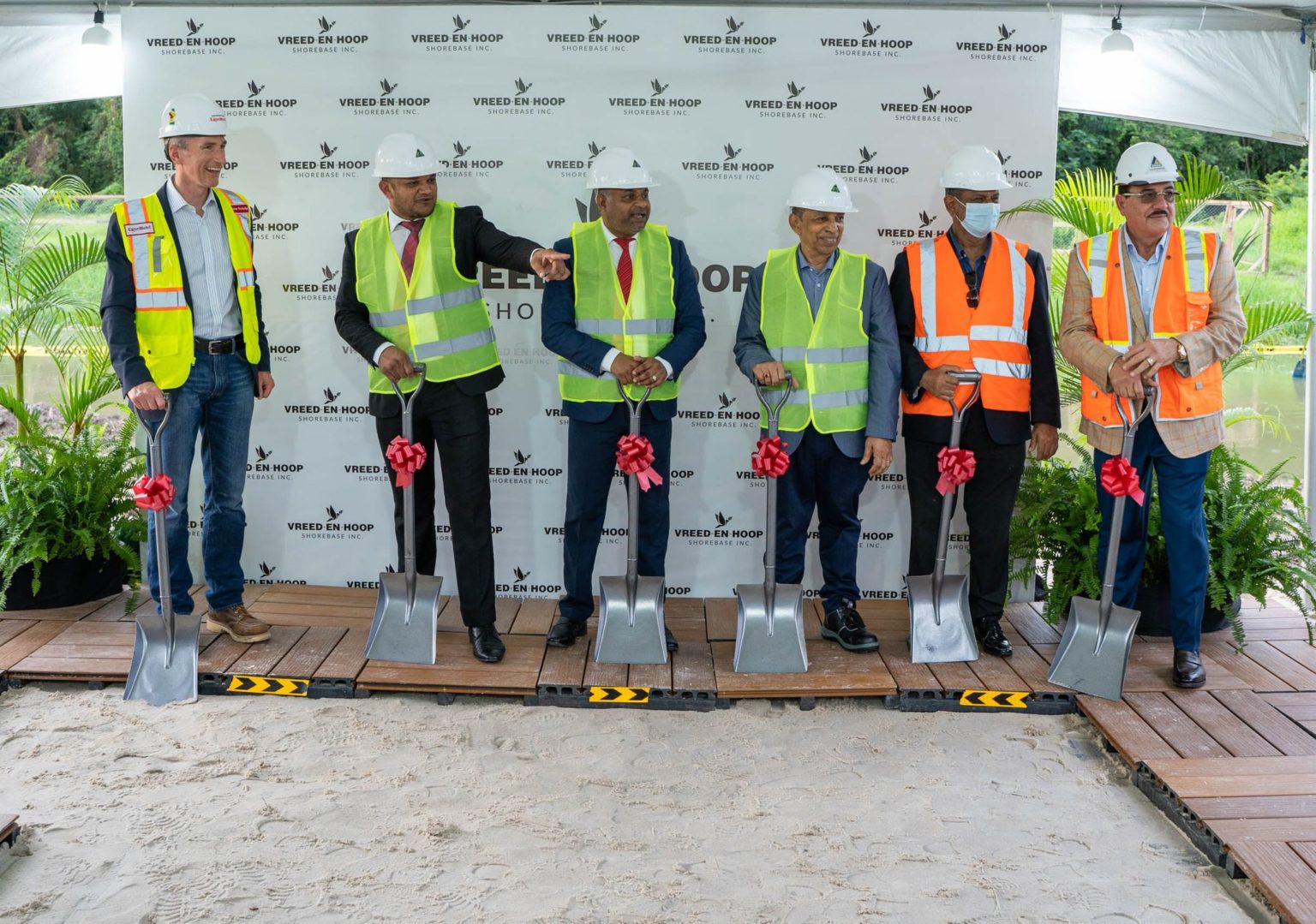
The July sod-turning event to mark the start of construction of the Vreed-en-hoop Shorebase
Vreed-en-Hoop Shore Base Incorporated (VEHSI) is looking to provide employment to residents of Region Three, where the company is developing a shore base facility. On Saturday, September 10, VEHSI is hosting a job fair to assess the hiring pool available on the West Bank of Demerara. The job fair runs from 10:00 hrs to 14:00 hrs at the Regional Education Office, Plantain Walk, West Bank Demerara (WBD).
VEHSI is a partnership between the 100% Guyanese-owned NRG Holdings Incorporated and Luxembourg-based, Jan De Nul—an engineering and construction firm which specialises in marine and offshore services, and has a minority stake in the project.
VEHSI’s Community Liaison Officer, Adonika Spellen explained that the company aims to recruit manpower from the region for integration into their projects. As such, the job fair is being held to give an accurate evaluation of the skillset available. From that assessment, VEHSI will undertake a capacity-building strategy to provide the training and skills required in pursuit of the company’s local content objectives.
VEHSI’s main project is a massive US$300 million Vreed-en-hoop Shore Base slated for operation by 2024. It is a component of the Port of Vreed-en-Hoop project, a multi-purpose facility on the foreshore of Plantation Best, West Bank Demerara.
It will include an offshore terminal, fabrication, umbilical and spooling yards. Administrative buildings will house offices and there will be modernised logistics centers, warehousing, container management systems, and potential for storage of sub-sea equipment, pipe inspection and repairs. There will also be areas for individual and separate operators to provide relevant services to the offshore oil and gas operators including but not limited to waste management/effluent treatment plants, other environmental services, lodgings, mud plant and logistics. An area is also earmarked for a potential helipad with an additional wharf, berths, and a dry dock.
The Port of Vreed-en-hoop project is a direct result of opportunities that are arising from the development of the oil and gas sector and its demands. It takes into account the untapped opportunities in terms of services that are required by the sector but are being provided by foreigners.
Guyana’s Local Content law intelligently crafted for win-win scenarios – Economist
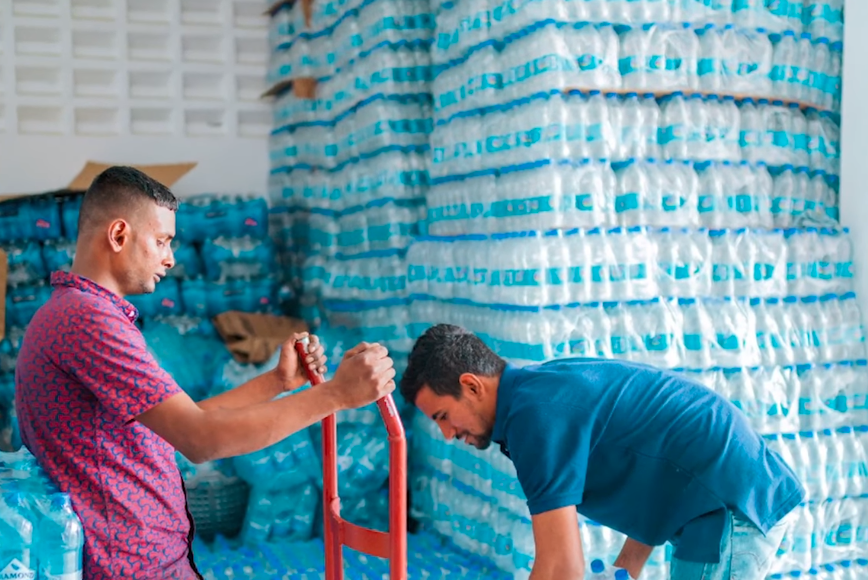
Workers loading supplies at the warehouse of a local logistics firm in Guyana.
Although Guyana’s Local Content legislation prioritises the use of locals across 40 categories of work such as rentals, security, transportation, and catering, it still does not block the participation of foreign entities. It is this intelligent craftsmanship of the law that creates win-win scenarios for all players, says economist and finance specialist, Richard Rambarran.
In a recent radio interview, Rambarran said the law is clearly demonstrative of the fact that the government has been very grounded in the realities of local content.

Richard Rambarran
“If you get local content wrong, you can have negative impacts on the economy, chase foreign investors away and slow down growth. Our Local Content law has been crafted in such an intelligent way that it provides a win-win under all conditions, and this is especially as it relates to foreign investment,” the economist pointed out.
He added that the definition of what constitutes a local company is proof of this.
“If you look at the definition of a Guyanese company, aside from the labour requirement element, but from an ownership standpoint, 51% has to be owned by Guyanese but 49% is still open to non-Guyanese,” Rambarran noted.
Guyana institutes mandatory 45-day payment period, amid complaints of long wait | OilNOW
He argued that the conditions of the First Schedule which require Guyanese companies to be prioritised in 40 areas of work still keep foreigners in play. As the Executive Director of the Georgetown Chamber of Commerce and Industry (GCCI), Rambarran said he often explains this to investors, thereby assuaging fears and clearing up misunderstandings.
He said too that one ought not to forget that there are over 180 areas of work in the sector but the law only ringfences 40. And that therefore, the extent of play for foreign entities is clearly still significant.
The economist said this type of messaging needs to be taken far and wide so that all players can truly understand that the law strikes a perfect balance for all stakeholders to benefit.
